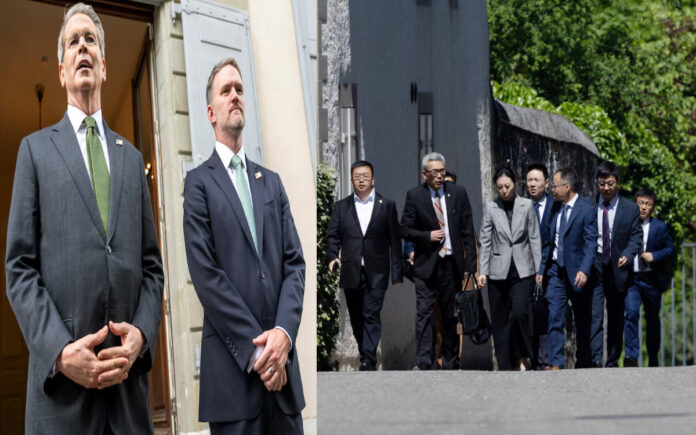Geneva: The United States and China concluded two days of high-level trade talks in Geneva with both sides describing the discussions as “constructive” and pledging to release further details in a joint statement on Monday. The talks marked a significant diplomatic thaw as tensions between the world’s two largest economies show early signs of easing.
U.S. officials characterized the outcome as a “deal” aimed at reducing the country’s global trade deficit, while their Chinese counterparts hailed “important consensus” and the launch of a new economic dialogue platform. Although no concrete measures were publicly outlined, both sides said the discussions had yielded meaningful progress.
Chinese Vice Premier He Lifeng, leading Beijing’s delegation, confirmed that a joint communiqué would be issued in Geneva. Vice Commerce Minister Li Chenggang added that the statement would bring “good news for the world”.
The US and China ended high-stakes trade talks on a positive note, with American officials touting to have clinched a 'deal' to reduce the trade deficit, while their Chinese counterparts said an 'important consensus' was reached https://t.co/Db1xSu53DP pic.twitter.com/Ky1c14JAX2
— Reuters (@Reuters) May 11, 2025
From the U.S. side, Treasury Secretary Scott Bessent and Trade Representative Jamieson Greer emphasized “substantial progress,” echoing their Chinese counterparts’ optimism. However, neither side mentioned any agreement on rolling back tariffs—namely, the 145% U.S. tariffs on Chinese imports or China’s 125% counter-tariffs on American goods.
Bessent and Greer refrained from taking questions during their briefing. Bessent had previously labeled the current tariff regime as tantamount to a “trade embargo” and advocated for its de-escalation.
Markets have closely monitored the Geneva summit for signs of relief from a long-standing trade war that has disrupted supply chains, caused layoffs, and driven up costs globally.
Greer referred to the outcome as “a deal we struck with our Chinese partners” and claimed it would contribute to reducing the U.S.’s $1.2 trillion global goods trade deficit. “It’s important to understand how quickly we were able to come to agreement, which reflects that perhaps the differences were not so large as maybe thought,” Greer added. He went on to describe He Lifeng, Li Chenggang, and Vice Finance Minister Liao Min as “tough negotiators.”
Speaking at China’s mission to the World Trade Organization, Vice Premier He Lifeng described the negotiations as “candid, in-depth and constructive,” emphasizing that “the meeting achieved substantial progress, and reached important consensus.” His remarks received applause from Chinese officials present at the WTO.
WTO Director General Ngozi Okonjo-Iweala, who met with He separately, welcomed the outcome and encouraged both nations to build on the progress to ease trade tensions. Although the WTO previously ruled against U.S. tariffs imposed under former President Donald Trump, those cases remain unresolved due to the U.S. blocking appellate appointments.
New Consultation Mechanism
As part of the Geneva dialogue, both parties agreed to establish a new consultation mechanism focused on trade and economic matters. Details of the platform will be finalized soon. This mechanism will join a long list of prior forums, including the 2023 Economic Working Group established under President Joe Biden and Vice Premier He, intended to navigate structural disputes between the two economies.
Historically, such dialogues have served as platforms to express grievances but have rarely succeeded in shifting Beijing’s state-controlled, export-led economic strategy toward one driven by domestic consumption—a long-standing goal of U.S. policy.
First Face-to-Face Since Tariff Blitz
This meeting was the first in-person engagement between senior economic officials from both countries since Trump launched his sweeping tariff campaign. Declaring a national emergency over the U.S. fentanyl crisis, Trump introduced a 20% tariff on Chinese goods in February, followed by a 34% reciprocal tariff in April, with subsequent hikes pushing duties into triple digits. This escalation has effectively frozen nearly $600 billion in two-way trade.
China has consistently demanded a rollback of tariffs as a prerequisite for any negotiation. Trump, however, indicated on Friday that an 80% tariff level “seems right,” hinting for the first time at a specific reduction threshold.
Greer emphasized that “a lot of groundwork” had been laid before the Geneva meetings, and the resulting agreement would directly address the trade emergency declared by Trump. “We’re confident that the deal we struck with our Chinese partners will help us to work toward resolving that national emergency,” he said.
A White House statement echoed the U.S. delegation’s brief remarks, headlined simply: “U.S. Announces China Trade Deal in Geneva.”
Broader Trade Agenda in Sight
In a separate appearance, White House economic adviser Kevin Hassett said China was “very, very eager” to re-engage and recalibrate its trade relationship with Washington. Speaking on Fox News, he noted that additional trade deals could be finalized in the coming days. Last week’s limited pact with the UK maintained 10% tariffs on many British goods.
Hassett said Commerce Secretary Howard Lutnick had briefed him on two dozen potential deals in the pipeline. “They all look a little bit like the UK deal but each one is bespoke,” Hassett said.
Also Read | Zelenskiy Challenges Putin to Meet in Turkey After Trump Urges Immediate Talks
In a late-night post on Truth Social, Trump applauded the outcome, calling it “a total reset… in a friendly, but constructive, manner.”
A Scenic Setting for Serious Talks
The meetings were held at a gated villa belonging to Switzerland’s U.N. ambassador in the Cologny suburb of Geneva, with black Mercedes vans seen arriving under tight security. Neutral Switzerland was selected as the host nation following outreach from Swiss officials during recent state visits to both Washington and Beijing.
The U.S. is seeking to reduce its $295 billion goods trade deficit with China and to encourage Beijing to abandon its mercantilist model—a change that would require significant political and economic reform within China.



